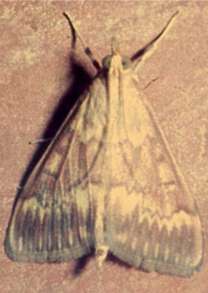Pests
Ostrinia nubilalis (Hbn). - European corn borer.
Classification.
Class Insecta, Order Lepidoptera, Family Pyralidae, Genus Ostrinia. It is a member of a number of poorly distinguishable and closely related species, such as O. furnacalis, O. orientalis, O. narynansis, O. scapulalis, O. zealis, etc., which occupy distinct geographic ranges and prefer to feed on different host plants.Synonym.
Pyrausta nubilalis Hbn.Biological group.
Polyphagous pests.Biology and morphology.
Adults of the European corn borer (ECB) are characterized by sexual dimorphism: males are smaller in size and colored darker than females on the average (wingspan of 23-32 mm). Life span is between 5-20 days. Fecundity varies in the range of 200-700 eggs, up to 1250 eggs at most. Eggs are laid as tiled clusters which include from 2 to 70 and more eggs (most often between 20 and 40). Development of eggs lasts for 3 to 9 days. Larvae develop during 20-45 days depending on temperature and reach body length in the last 5th instar up to 28 mm. Most of the time larvae feed buried, making tunnels inside plants, most commonly stalks, where they penetrate during 1st (millet) - 3rd (maize) instar. Larvae over-winter inside plant debris after finishing their feeding. Pupae vary in coloration (between hazel and dark-brown) and body weight (from 25 to 120 mg). The pupal development lasts 10-25 days.Distribution.
The ECB is widespread in Europe, western and central Asia, northern Africa, and introduced into North America. In Russia it is widely distributed in steppe, forest-steppe and southern taiga zones.Ecology.
A single generation of insect develops in most areas, although two generations occur in the North Caucasus, and up to three generations may take place in Central Asia and Transcaucasia. Adults fly during different periods depending on the zone and their flight is frequently extended. In central European Russia, flying usually occurs during June - July; in the North Caucasus, over-wintered adults fly from the end of May to the beginning of July; adults of the first generation fly from the end of July to the end of August. Adults are capable of flying across tens of kilometers in search for places suitable for oviposition. For oviposition to begin, adults need water. Lack of water also prevents hibernated larvae from starting their pupation. Therefore insect distribution depends on precipitation during the spring and summer periods. Hibernating larvae survive easily after long periods of very low winter temperatures. Insect population may depend on activity of entomophages (parasites and predators) and alimentary quality of its host plant variety. Geographical distribution is tending to expand northward due to expansion of grain production of maize and warming of climate.Economic value.
The ECB causes the greatest damage to maize as well as millet, hemp and hop; it is capable of injuring peppers, sorghum, soy-bean, and cotton. It infests thickly-stemmed wild-growing plants and weeds, such as wormwood (Artemisia spp.), clotbur (Xanthium spp.), chicken panis grass (Echinochloa crus-galli), bur-marigold (Bidens spp.), common ragweed (Ambrosia artemisifolia), and others. Some pests closely related to the ECB species, in particular, O. furnacalis in the Far East, cause damage to agricultural crops, primarily maize. Control measures: close cutting of plants during harvest, careful pounding of plant debris, deep pre-winter plowing, spring harrowing; insecticide treatment of plants before larval penetration into stems as well as .action places. of adults prior to the beginning of mass egg-laying; releases of parasitic Trichogramma spp. and Habrobracon hebetor; cultivation of resistant varieties and hybrids.Reference citations:
Frolov A.N. 1998. Variation in the European corn borer, Ostrinia nubilalis, and allies (Lepidoptera, Pyralidae). Mem. Soc. r. belge Ent., 38: 71-105.Kozhanchikov I.V. 1938. Geographical distribution and physiological characters of Pyrausta nubilalis Hbn. Zool. Zhurn., 17(2): 246-259. (In Russian)
Mutuura A., Munroe E. 1970. Taxonomy and distribution of the European corn borer and allied species: genus Ostrinia (Lepidoptera: Pyralidae). Entomol. Soc. Canada Mem., 71: 112.
Shchegolev V.N. 1934. The European corn borer (Pyrausta nubilalis Hb.). Leningrad-Moscow: All-Union Acad Agric. Sci/All-Union Inst. Plant Protect. 64 pp. (In Russian)


